Daisy lived at Lantarnam Hall until the late 1920's, when she
joined her sons in Southern California. John and Percy Jr. founded
Hollywood's Cock 'n Bull British-style pub and restaurant, 9170
Sunset Boulevard; the place is credited with introducing vodka
to American tastes by mixing a drink called the Moscow Mule. John
Ainsworth Morgan was a published author and screenwriter.
Lantarnam Hall passed to a series of owners, many of who found
upkeep too much. The years of occupancy I'm going to cite are
approximate, as sources give different years or omit some owners.
The first owner was local contractor Frederick Rolandi, who bought
the property from Daisy and lived there until probably the late
1930's. The next occupants were a flamboyant San Bruno nightclub
owner, Gypsy Buys, and her husband Jerry, an opposite, reserved
personality.
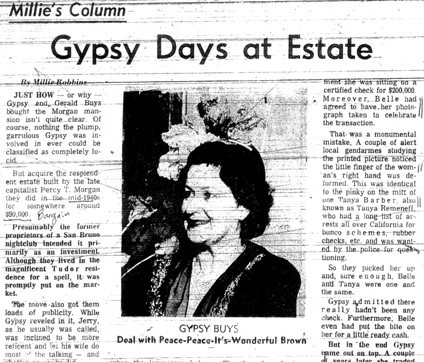
Gypsy and Jerry Buys lived in the mansion apparently just incidentally,
Gypsy's plans being to make it a hotel-country club-resort - whatever
- but the neighbors blocked the Buys from getting a business permit
for whatever it was they wanted to do.
The rumored next owner was charismatic Father Divine, possibly
born George Baker, an east-coast religious leader, whose Peace
Mission had national and international chapters. Father Divine
being African-American the neighbors got really alarmed and tried
pooling their money to buy the property themselves, but the deal
with Divine apparently fell through.
The next prospective owner was picturesque. In the late 1930's
Gypsy Buys announced that she had a confirmed sale to one Belle
Silver, an affluent Nevada hotel-motel operator who had offered
$200,000 for the property and planned to make it a swank recreation
area. Silver would install a pavilion, restaurant, and other improvements.
Newspaper reporters who wanted details were told that despite
her business acumen, Silver was shy and preferred not to be interviewed.
Jerry Buys may have been skeptical but was told to keep quiet.
When the transaction was supposedly complete, Belle agreed to
be photographed for the newspapers. It was a mistake. Police noticed
that the her right-hand little finger was deformed, a characteristic
of one Tanya Barber, who was wanted for questioning in connection
with bunco, bad checks, prostitution, and other offenses. Belle
Silver, a.k.a. Tanya Barber, a.k.a. Tanya Remeneff, was arrested.
Gypsy Buys admitted she hadn't really concluded a deal with her,
in fact Belle had asked her to "advance" money. Gypsy
Buys finally unloaded the property on a real estate man, William
E. Doud, who gave her a hotel on Eddy Street in San Francisco
as part of the deal. Some years later Jerry Buys committed suicide
at the hotel.
According to one source Doud did not live in the house, but even
so he had to sell off all but about ten of the original 100 acres
to pay property taxes and possibly maintenance costs. About 1952
the house got a stable occupant who would put it to good use.
In 1935 educator John Carter Ford began the Ford Country Day School
in Los Altos. Ford had founded the Palo Alto Summer Theatre for
children at Castilleja School and directed five seasons. Ford
School's Los Altos location was a cramped two-room building. Ford
School needing a bigger location and Doud needing to divest himself
of Morgan Manor, they traded, an advantageous deal for both.
 Mr. and Mrs. John Ford, founders of the Ford Country Day School,
on the grand staircase of the main entry hall
Mr. and Mrs. John Ford, founders of the Ford Country Day School,
on the grand staircase of the main entry hall
Ford modernized the house's wiring, plumbing, and heating, added
classroom facilities, and opened his school's new location in
1955. In 1959 the school hired teacher Brent Warner. Just as Warner
took a leave of absence in 1961 to assist in President Kennedy's
physical fitness for youth program, Ford and his wife told Warner
that when they retired they would like him to assume the school's
management. A year later the Fords were ready to sell the school,
purchase price $200,000. Warner couldn't come up with the money
himself, but by negotiating loans from the Fords got enough for
the down payment.
Warner was only 24 when he took over Ford school's management.
He added 7th and 8th grades, and improved the facilities. Ford
Country Day School had an enrollment of 200 in the 1970's, apparently
its peak. Many of Warner's students remembered him with great
fondness. When Warner died in 2007, John Inman, a Ford student
in the 1960's, posted a touching web site tribute "He Turned
My Life Around."
…when I was in 5th grade, my school first discovered
that I could not yet read 1st grade materials. My parents sent
me to batteries of testing, psychologists, etc. to try to figure
out what the problem was. My IQ was high, but I had severe problems
in learning. They discovered that I was dyslexic. Thank God
I had parents that cared enough to find a solution. We visited
many private schools including a military academy and visited
Brent and Ford Country Day School. This is truly the beginning
of the story.
…we were not an affluent family. When my parents sat down
with Brent, he reached out to help. He arranged for my tuition
to be offset by my mother driving students to school in her
station wagon. I have no idea to what extent this actually off
set my tuition, I do know however, without Brent reaching out
to my family, my life would have taken a turn for the worst.
Brent and my parents agreed to have me retake 5th grade and
to start the next school year.
I can not even begin to explain the terror I experienced joining
a school with such extraordinary academic standards, not being
able to read, and leaving all of my friends behind, permanently.
Brent's kind and loving support and that of his outstanding
staff, helped me slowly learn to grow and overcome my learning
disability. Ford Country Day School has become the most important
turning point in my life. We had a great class and I to this
day look at our class pictures and remember my classmates. I
often wonder how they are all doing!… What an extraordinary
experience. The foundation that Brent gave me has in many ways
set my direction in life.
Ford Country Day School continued at Morgan Manor for 33 years,
until 1988, when finances, particularly insurance costs, forced
it to close. The house was sold to a private party.
By 1999 the house had deteriorated badly and was up for sale
again. Venture capitalist Kelly Porter and his wife Christina
saw an advertisement by Coldwell-Banker realtors, and went to
the property.
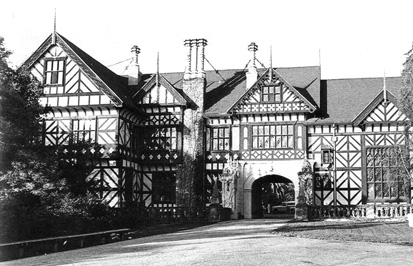
Kelly Porter described it as looking like "a beat-up fraternity
house:" broken windows, cracked chimney pots, the grounds
neglected. The Porters saw it as a challenge. After buying the
house they hired architect Richard Beard of BAR Architects. Beard
arrived for his first visit with no idea of what he would find.
"But then there it was," said Beard, "this fantastical
structure that looked as if it had been dropped in from who knows
where… I had to compose myself before getting out of the
car."
Because the house - now Stonebrook Court - has historic
designation, its restoration had to conform to Department of the
Interior standards. Beard's additions had to look like they had
always been here. Kelly and Christina Porter searched Europe and
Asia for furnishings that conformed to the house's style and their
own tastes. Landscape designer Stephen Suzman of Suzman &
Cole Design Associates completely redesigned the entranceway.
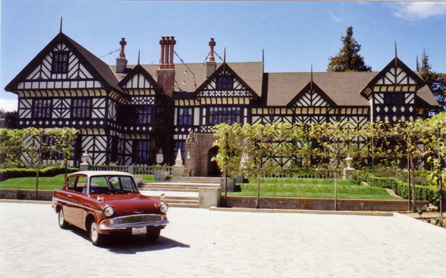
Stonebrook Court, April 2009
Images Courtesy "Ralston
Independent Works"
Remarkably, Stonebrook Court is practically invisible from the
main road. A sharp left turn brings you through trees, then at
the top of the road the house suddenly appears. Suzman added a
splendid garden in back, with boxwood parterres and long perennial
borders.
Exterior


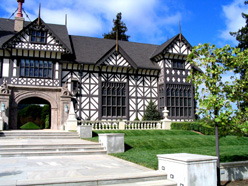
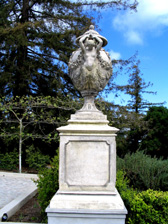
Four stone entryway pieces 1660-1775 are from the home of Irish
dramatist Richard Brinsley Sheridan
Images Courtesy "Ralston
Independent Works"
Entrance hall
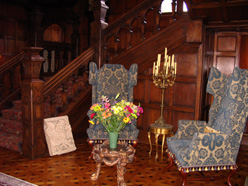
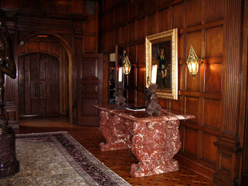
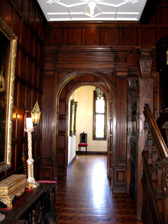
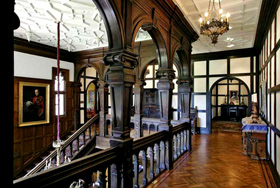
The second floor
The plaster ceiling in the grand stair hall has mahogany detailing.
Images Courtesy "Ralston
Independent Works"
Kitchen, Breakfast Room & Family Room
Beard revamped the kitchen to include a coved ceiling; the arches
are echoed in the gothic windows in a new breakfast room.
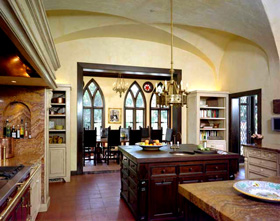
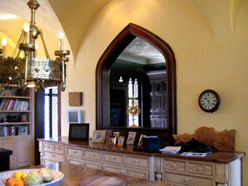
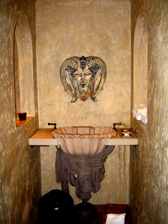
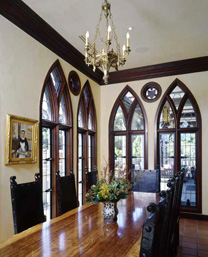
1935 chandelier above the island is from a chateau in France.
The island is dark mahogany with honed, paprika-colored onyx counters.
Beard added a breakfast room with Gothic arch windows.
Images Courtesy "Ralston
Independent Works"
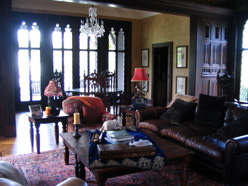
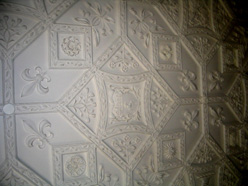
Family room. Beard's changes in the family room included a molded
plaster ceiling designed by Czech artist Batbajar Gongorzar. The
squares include representations of the Porters' children as mythical
animals.
Terraces
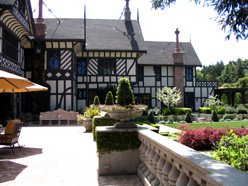
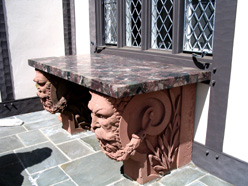
Beard added terraces outside the family room and kitchen.
Images Courtesy "Ralston
Independent Works"
Staircase, Murals and Wine Cellar
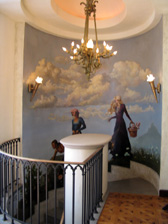
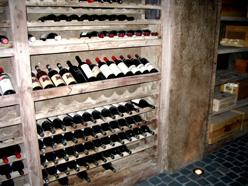
Murals on the staircase are by San Francisco artists. A spiral
staircase leads to wine cellar
Beard added a wine cellar with temperature control, necessary
to age the Porters' Bordeaux, Burgundies, and other wines. Bordeaux
wines include all five first growths.
Images Courtesy "Ralston
Independent Works"
Formal Dining Room ("Francis I Room")
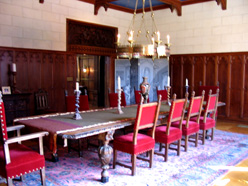
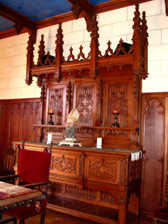
A carving from Bruges, Belgium is above the dining room door.
The sideboard is the only original furniture from Morgan Manor
Images Courtesy "Ralston
Independent Works"
Living Room and Library
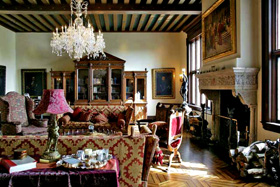
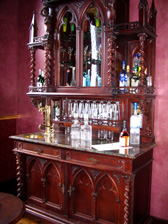
This was the 3rd grade room at Ford Country Day School. The library
was rebuilt with floor-ceiling bookcases. One panel opens to a
secret room; reminds one of the secret priest rooms in Speke Hall
- there were no priests, but there is a wet bar and beer taps
connected to casks in the basement.
Images Courtesy "Ralston
Independent Works"
Master suite
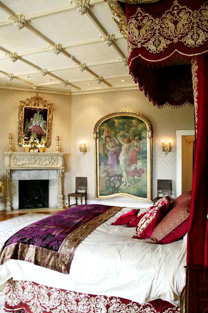
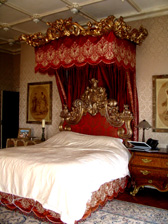
Back upstairs we are in the master bedrooms and baths. Ivory
damask on the walls contrasts with ruby and gold canopy over the
headboard. The headboard is an approximate replica of one of Henry
VIII's beds. The wall painting is the Three Graces, from a 19th-century
Pittsburgh estate.
Images Courtesy "Ralston
Independent Works"
Master Bath
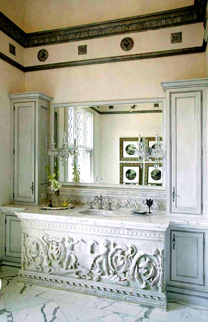
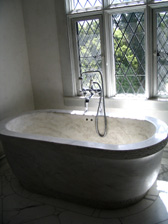
The marble bathtub, from India, was chiseled from a single marble
block.
Images Courtesy "Ralston
Independent Works"
Please continue with Part 3
of the presentation, The Grand Ballroom and Grounds
